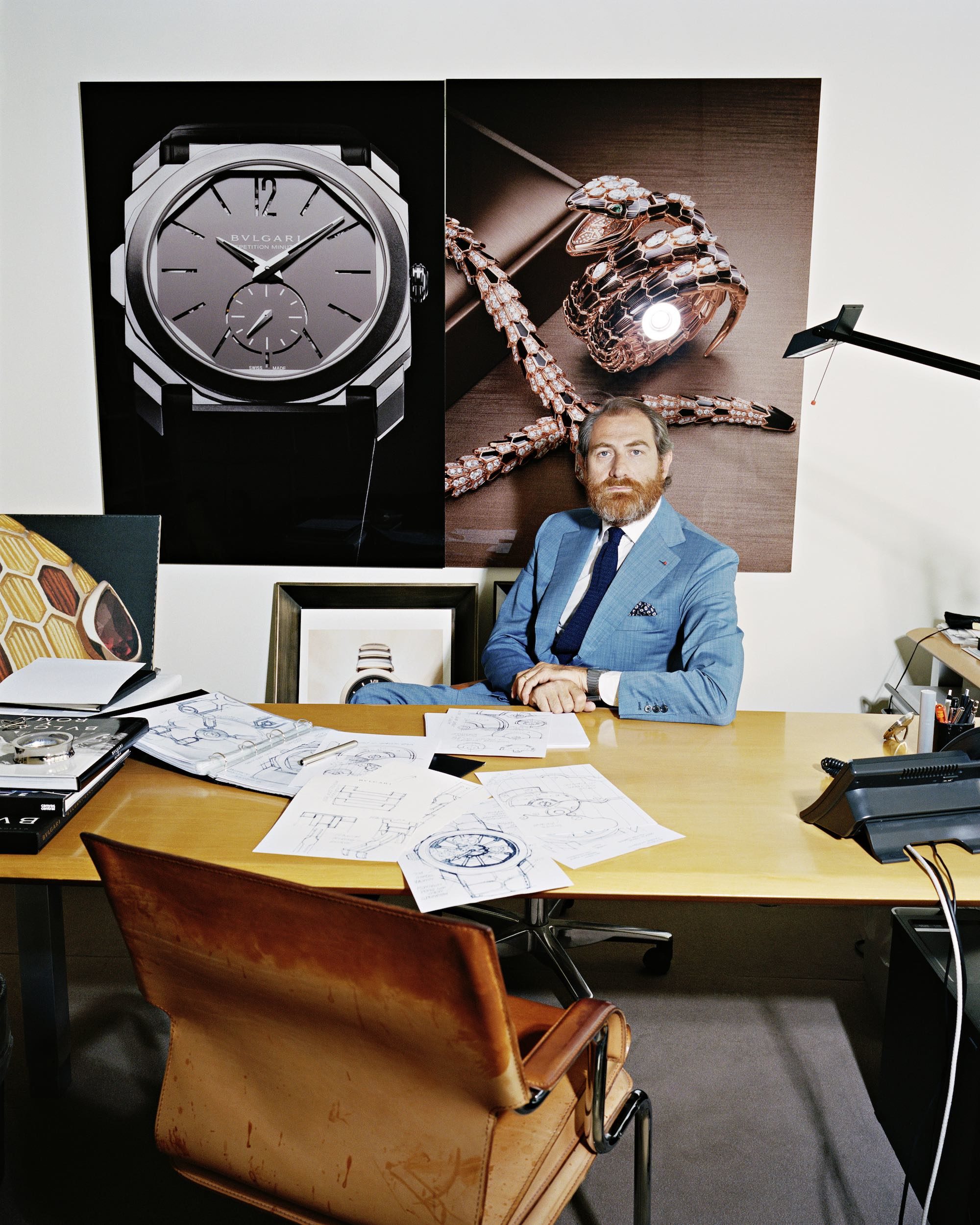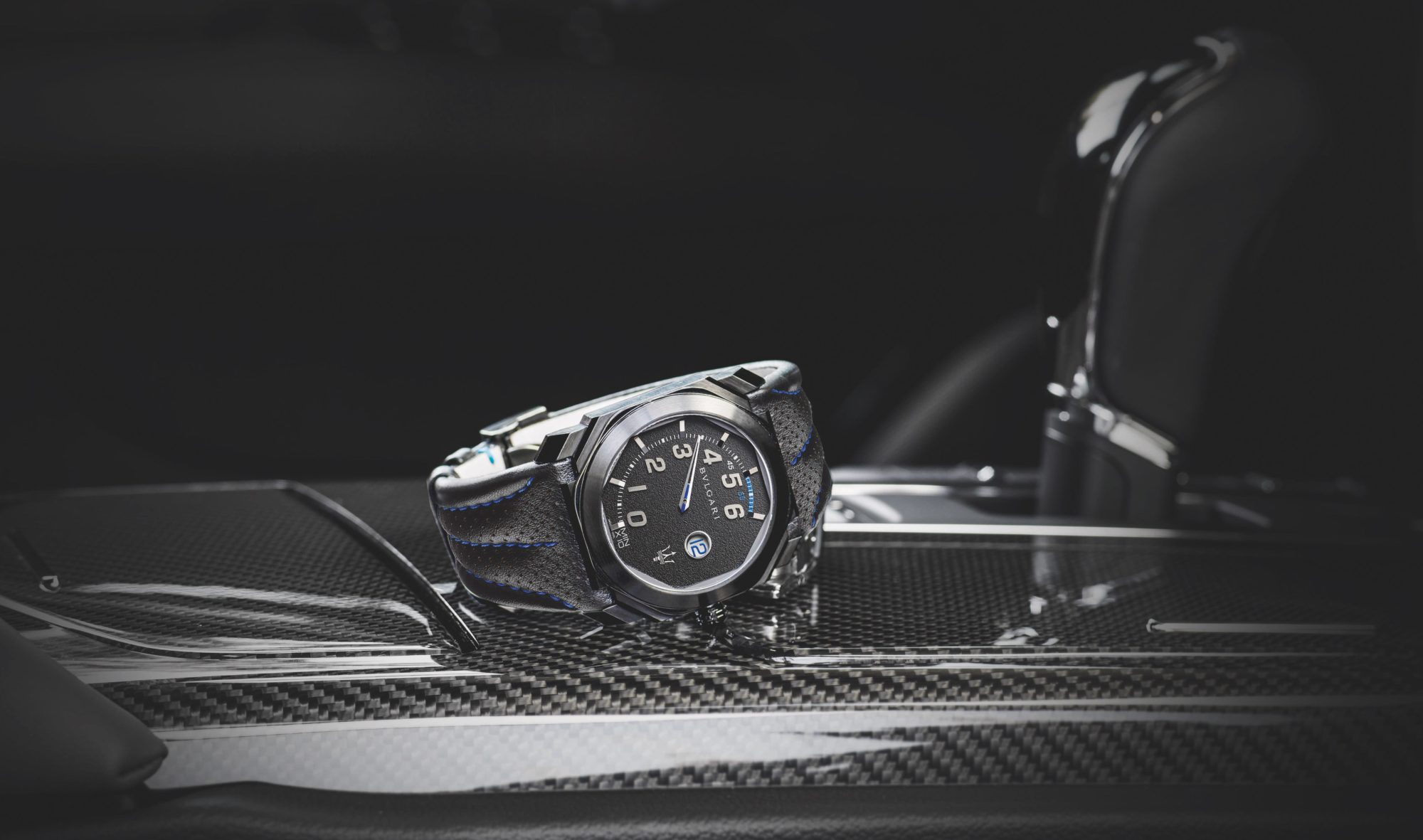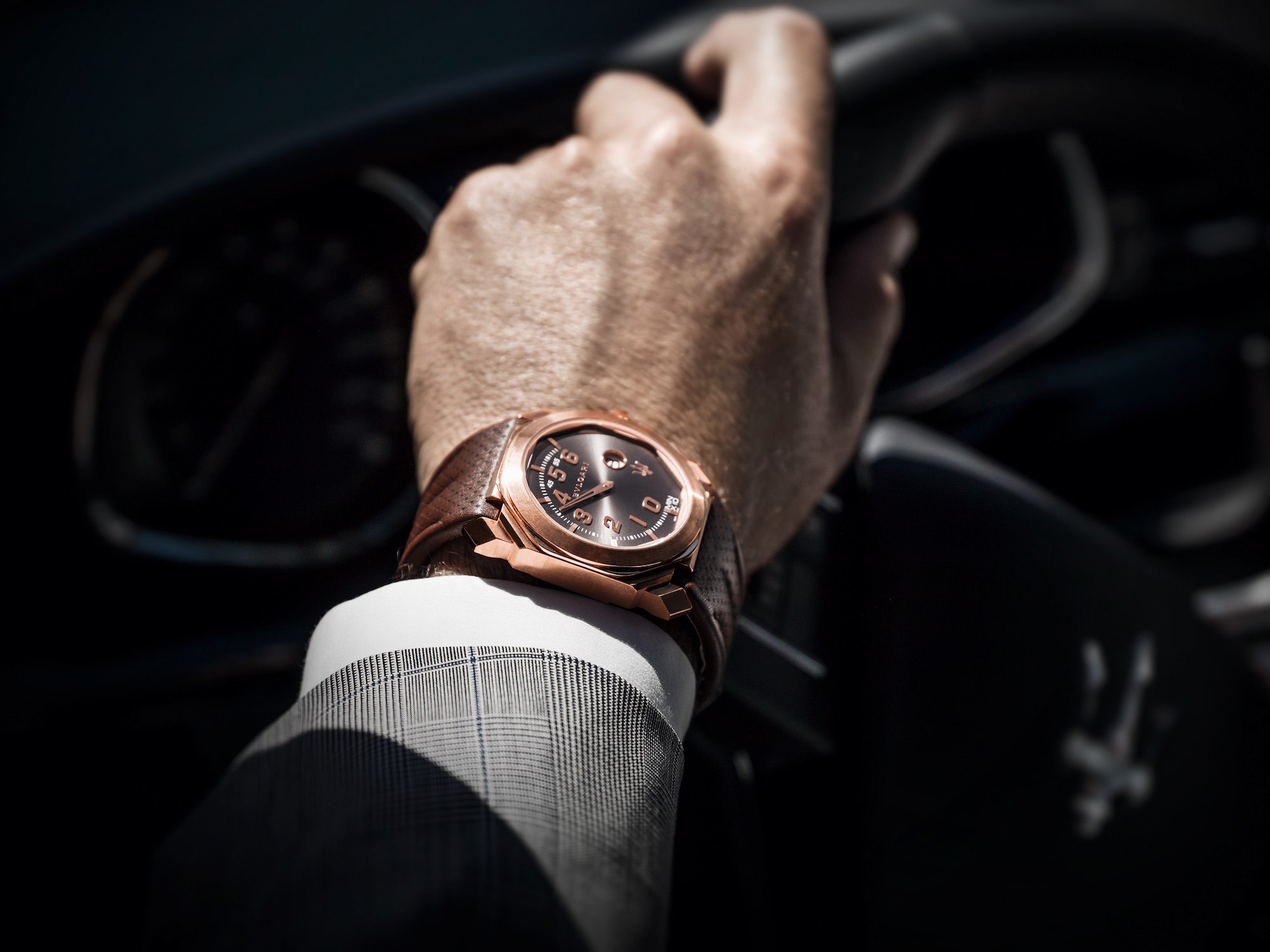On a sunny Wednesday morning late last year, Fabrizio Buonamassa found himself behind the wheel of a sleek twin-turbocharged sedan, juking through traffic in downtown Palm Springs, making a beeline for the deadliest road in America.
Buonamassa, the 46-year-old head of watch design at Bulgari, had never been to California. The night before, he’d paced slowly across the rooftop at Chateau Marmont, taking in the Los Angeles skyline, seeming pensive. But when he arrived in Palm Springs, an unsuspecting publicist tossed him the keys to a new Maserati Ghibli. Buonamassa promptly set the navigation to Route 74, that infamous widowmaker of a mountain road running into Coachella Valley, dropped the windows, and laid down two fat strips of rubber exiting the hotel parking lot.
“Police?” he said, slowing the Ghibli from felony to misdemeanor speeds, eyeballing a suspect black-and-white sedan in the opposing lane.
When it passed, he shrugged, downshifted, and ripped into the throttle again. “Hah!”
Ostensibly, Buonamassa was in town for the Los Angeles auto show, celebrating the new collection of Bulgari x Maserati watches. The collaboration brings together two titans of Italian design—the former company being Rome’s premier jewelry house, the latter Modena’s oldest luxury automaker. For Bulgari, now owned by Paris-based luxe conglomerate LVMH, it’s an assertion of the brand’s domestic sensibilities. For Maserati, which has seen sales increase tenfold over the past decade, it’s an opportunity to bake in an additional layer of exclusivity. (The new watches are available only to Maserati customers.)
Joint ventures between watch companies and automakers can feel nebulous or contrived. But Buonamassa brings a unique credibility to this one. He grew up in Naples and studied in Rome, worshipping at the altars of Bertone and Zagato and Pininfarina, the famed carrozzeria that coach-built bodies for Ferrari and Alfa Romeo. Before joining Bulgari in 2001, he actually served as an auto designer at Fiat Group, Maserati’s corporate parent. It was the realization of a childhood dream.
“If I have to make a choice, my heart is closer to the Italian vintage cars than the Swiss watchmaking heritage,” Buonamassa admits. “My father, he was working for Hertz, you know, the rental car companies. He would travel and bring me home books of cars from around the world. I was sketching them from the age of four or five, and this is what I enjoyed drawing first—the cars. But I have always loved designing product. This idea of making emotion from an object. I just love it.”
The new Bulgari x Maserati collection is a testament to that fascination. It includes two pieces: the race-skewed GranSport (carbon-treated steel case, black leather strap with electric-blue contrast stitching to match a Maserati bucket seat) and more formal GranLusso (18-karat pink gold case, grey sunburst dial, padded chestnut band). Buonamassa wanted to riff on octagonal shapes, a longstanding Bulgari motif, while cleverly integrating elements of a vintage sports-car dashboard.
So the GranSport and GranLusso ditch the traditional two-hand watch layout for a so-called retrograde arrangement, wherein a single hand sweeps a linear path to indicate minutes, recalling tachometer needle. Hours are shown through a crystal aperture at the three o’clock position, clicking off like an odometer. Both watches measure a modest 41mm in diameter, use a neat automatic movement, and are assembled in-house at Bulgari. More important, both pieces look and feel as unimpeachably Italian as the man who designed them.
Back in Palm Springs, having crossed Route 74 off his bucket list, the lanky Buonamassa strode across the courtyard at The Parker hotel, hands in his pockets. Wearing an impeccably tailored blue jacket, Jacob Cohen denim, and purple Persol sunglasses, he stopped to admire a large bronze statue of a half-peeled banana, installed on a grassy patch next to his room. Astrud Gilberto’s “Portami con Te” played over a lawn speaker. He hummed along with the refrain, smiled, then checked his watch.
“Oh!” he said. “Time for lunch.”
Fabrizio Buonamassa’s Tenets of Good Design
In the beginning, I started to appreciate beautiful drawings. Design was a consequence, because it gave me the opportunity to make sketches. This is why I’m a designer. I’m lucky because my profession is to make drawings.
In my career, I design a lot of different things. I think that a designer should be able to do this. Honestly, the process is sort of a small mystery, but the approach is the same for airplanes, for cars, for watches, for furniture. You have to solve problems. You have to know the problems and imagine solutions, and you have to do this in a beautiful and unique way.
Design is a compromise. Even the credit process. And if you do not trust your idea, it’s impossible to sell, even to the boss. So I have to imagine something, to start to make sketches, to tell you I think that this idea is correct. The sketch is just a skill, it’s just a tool because sometimes I need to fix the image that I have in mind. But I have to trust the idea.
My job is to turn technology into emotions. This is the case with the Octo Finissimo, the thinnest automatic watch in the world. I have to know the technology, and I have to be able to transform it into something that makes sense to the client. Otherwise, it’s just a movement. Yes, okay, it’s a fantastic movement, but this is the role of the designer. And I have to do this through the iconic signs, the codes of the brand, and the heritage of the brand.
We have a word in our vocabulary, sprezzatura. That means you can make something very complex in a natural way. The most important innovations are made by simple things. And the simplicity, like Leonardo da Vinci says, is the latest complication. [The Octo] is very difficult to produce, but it works very well. It’s strong enough for everyday life, and it looks absolutely simple. This concept of sprezzatura, for the first time you can find it in watchmaking. Because in Swiss watchmaking, you can find a lot of watches that are very hard [to produce], but also very difficult in terms of language. How can I read the time?
If a product is able to talk to you about its function, I’ve done a good job. Good design expresses itself. If I tell you the watch is this, this, and this, and that you have to use it this, this, and this way, maybe it’s not a good design. It’s another thing.
The retro trend, it is copy-and-paste design. For some brands, it’s easier to open the desk and say, ‘I want to make the new edition of this watch.’ This is not our approach … Bulgari started to use [octagonal shapes] in the 1950s. Our [new] watches [the GranSport and GranLusso] are the same shape, but with different attention to the details of the faces. It still performs, but in a contemporary way. This is the signature of the brand. When you see this watch, you cannot make mistake it. But when you see this watch compared to a vintage one, it’s two different worlds.
We don’t have a creativity issue at Bulgari. We don’t just put the logo on a watch and say it’s a Bulgari x Maserati, because we have a lot of ideas. The idea [for the GranSport and GranLusso] was to tell you the time in a different way—to tell you the time as a rev counter, as in the dashboard of a car, thanks to our retrograde and jumping hour movement. The number on the watch dial, it is the same font on the Maserati dashboard. After that, it’s a matter of color. The GranSport is very dark. It’s a nod to the performer. The GranLusso, it’s more exquisite. It’s more elegant, more luxurious. This is the two faces of the Maserati, the brand that invented the gran turismo, the kind of cars driven not only by performance but also luxury.
Bulgari and Maserati have a lot of elements in common. Both Italian brands made by [families], the Maserati sons and Sotirio Bulgari with his sons, Giorgio and Constantino. Very strong entrepreneurial skills. The same attention for proportion, the same attention for beautiful things. [The Octo] is an impressive watch in terms of technical skills, let’s say ‘performance,’ but it’s not the first thing you notice. Maserati is the same. It’s engine technology, performance chassis. But when you look at a Maserati car, first of all you see that it’s beautiful.
Italians have a different perception of beauty. We have a lot of layers of culture—in terms of arts, in terms of taste, starting centuries and centuries ago. In the middle of the Mediterranean area, a lot of different people spent time in Italy and left something. The Roman Emperor was very impressive and important. This is part of our heritage. We have a certain aesthetic sense, but it’s very difficult to explain, maybe impossible. Because we don’t have one word to say why the Italians are different, why our taste are so unique. But it’s strange because you can see. You can feel, you can taste, and you can hear. Beauty for us is not a philosophical concept but an experience. I think it’s impossible to make this blend outside Italy. Each time you try, it’s fake.


